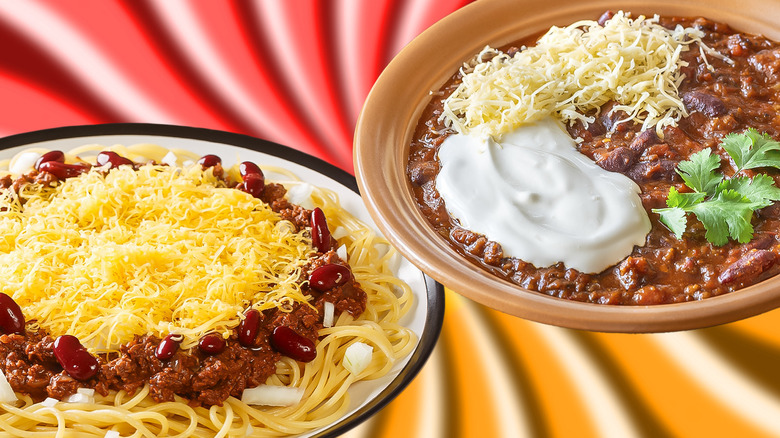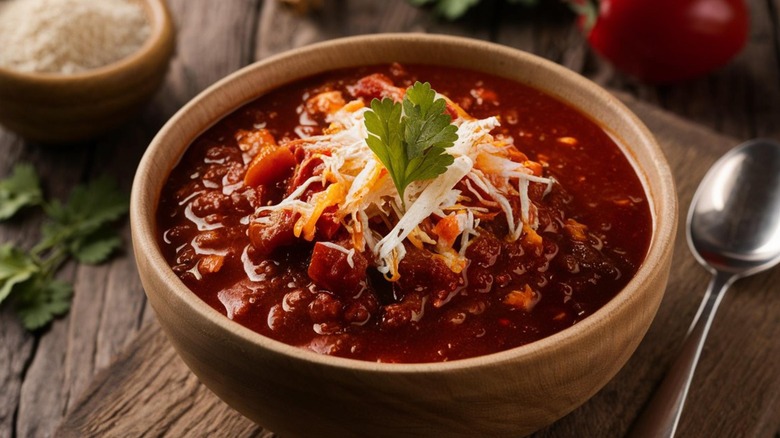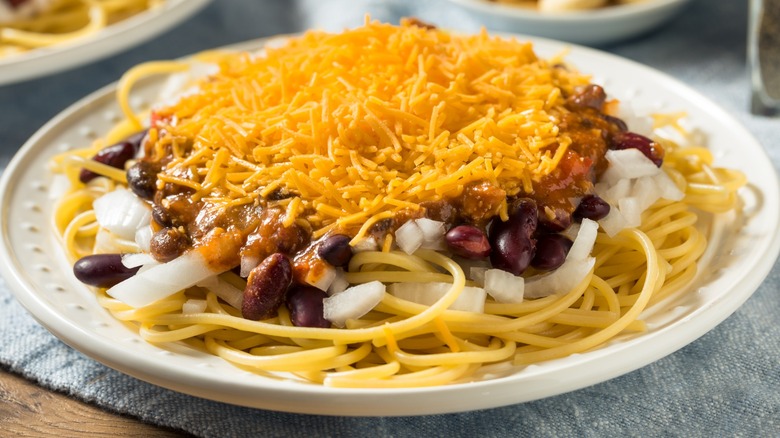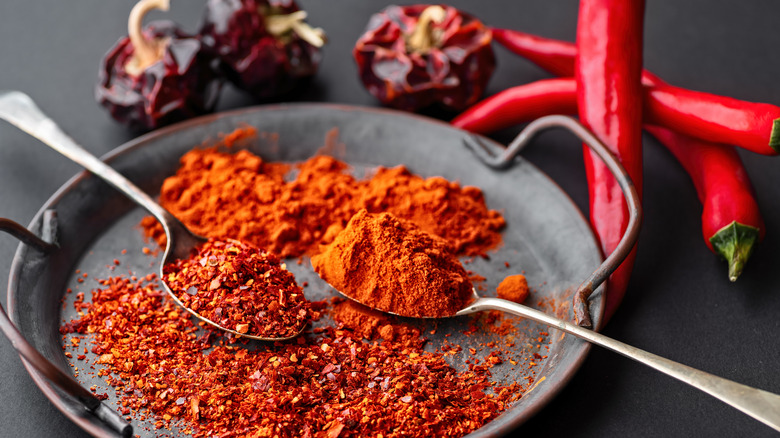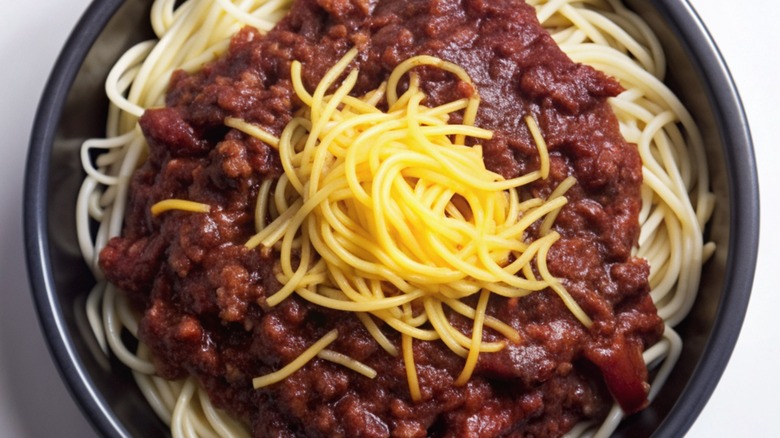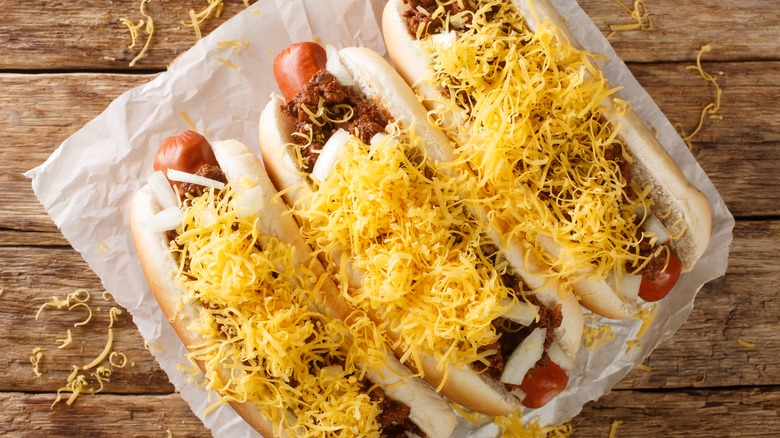Cincinnati Vs Texas Chili: What's The Difference?
You don't have to be a sociologist to know that Americans love chili. The delicious stew takes many forms as you wander across the States, and local preferences are often heartily defended against what are perceived to be foreign chili imposters. Two of the most hard-fought battlegrounds in the American chili wars are Texas and Cincinnati, Ohio. The exact origin of chili is a bit of a mystery and legends run wild. One legend claims it was a product of the Aztecs. Only, instead of using beef for the meat, they sacrificed prisoners of war and ate them alongside chili peppers and tomatoes.
A less gruesome legend has it that the recipe came from a Spanish nun who visited Native Americans in Texas via astral projection and returned with the recipe in hand. Tall tales abound, but the general consensus is that chili as we know it today originated around the middle of the 1800s in the small towns that nestled themselves along the border between Texas and Mexico. By the 1880s, chili vendors had set up food stands in San Antonio, Texas, and the recipe slowly spread from there.
While the two dishes both have "chili" in the name and include beef and spices, the similarities pretty much end there. Texas chili is served as a standalone stew and never includes beans, while Cincinnati chili is more gravy-like and freeform. Here are the key differences between the two, explained.
What is Texas chili?
Since Texas is most likely where chili was first created, there's a good argument to be made that proper Texas-style chili, also called Texas red chili or chili con carne, is as close to the original recipe as we can find. Chili con carne has been Texas' state dish for almost half a century, and there are very specific rules about how it ought to be prepared, the most famous of which is the unwavering rejection of any and all beans. But we'll dig more into the ingredients when we start talking about what makes these two versions different.
The chili vendors that were operating out of San Antonio back in the 1880s were known as Chili Queens, and they're often credited for jumpstarting the culinary aesthetic that would grow into what we now know as Tex-Mex cuisine. They would continue operating until 1940 when new regulations arose, but the chili they helped San Antonio fall in love with made its way across the great state of Texas in the ensuing years. The Chicago World's Fair in 1893 marked the official introduction of the Texas dish to the rest of the country. Shortly after, you began to see chili parlors cropping up all over the States – including in Cincinnati.
What is Cincinnati chili?
Cincinnati chili was popularized by the fast food chains Skyline Chili and Gold Star Chili, but its history goes back much farther. Cincinnati is predominantly known as an old German town, and it was the Cincinnati Germans who first created goetta (another Cincinnati food staple), but German immigrants can't claim the city's iconic style of chili. That honor goes to the Greeks, thanks to the two brothers Tom and John Kiradjieff, who immigrated to America from Macedonia in the 1920s.
In 1922, they opened Empress Chili Parlor, and Cincinnati chili was never the same again. Their classic Cincinnati chili married all the great flavors of American chili with the spices and flavors that were popular in Greek Macedonian foods, like the meat and veggie casserole known as moussaka and the Greek version of lasagna known as pastitsio. These culinary inspirations could also help explain why Cincinnati chili is often served over spaghetti noodles and topped with heaping doses of cheese and a side of oyster crackers.
The texture of Cincinnati chili doesn't get very much love from people who aren't familiar with it since it typically looks more like a meaty gravy than a chunky stew, but the unique flavors are undeniable. Most people don't eat Cincinnati chili on its own, anyway. But we're getting ahead of ourselves, so let's dig in.
Different spice blends give these chilis very different flavor profiles
There may be some rare exceptions that we aren't familiar with, but the general consensus is that all chili is flavored with either chili powder or whole dried chilis. It's where the name comes from, after all. But beyond that, there doesn't appear to be any real restrictions on what flavors can constitute a chili. A true classic Texas-style chili is old school by only including a mixture of different whole dried red chilis to flavor the dish, including chipotle, ancho, costeño, and cascabel chilis, etc.
There are a few ways to add these to the dish, but grinding them up and tossing them in isn't all that uncommon. Masa harina is then added to the broth to thicken it up, though it doesn't add much in terms of flavor. But while this is the traditional way, it's fairly common to see modern Texas chili makers add other spices like cumin, smoked paprika, and oregano to the pot. The debate in Texas over what spices are acceptable remains a highly contentious one.
Like we mentioned earlier, Cincinnati chili draws from its Greek Macedonian roots and mixes chili powder with clove, nutmeg, all-spice, oregano, garlic, bay leaves, and cocoa powder to create a flavor profile that isn't terribly spicy but boasts pleasantly warm spice notes. The Tex-Mex influence is much more subtle here, as you can see, but it isn't altogether absent.
The two styles both use beef, but not in the same way
You can make chili with different sources of protein, but beef is clearly preferred over other options. Both Cincinnati chili and Texas chili use beef. The difference is how the beef is prepared. With classic Texas chili, you get big chunks of beef in the form of diced cubes of beef chuck or something similar. These are usually seared slightly before being thrown into the broth. This creates a hearty mouthfeel for people to sink their teeth into, an important feature since Texas chili is always served on its own.
There are lots of modern Texas chili recipes that call for ground beef, probably because of how easy it is to cook with, but it's certainly not the traditional way. Cincinnati chili sees Texas' big chunks of beef and runs in the exact opposite direction by using finely ground beef. The beef is so finely ground, in fact, that it often gets lost in the sauce, which helps give it the gravy-like texture we mentioned earlier. Although it throws people who aren't used to thin chili off, it makes it much more practical as a sauce since you won't be trying to balance a big block of beef on top of your coney dog.
Texans are strongly against adding fillers to their chili, but Cincinnati embraces them
What exactly constitutes a filler in chili isn't as clear as it could be, but whatever the definition means, it definitely includes beans, pasta, and rice. Beans, in particular, appear to be the primary offenders. You will never find beans in a true Texas chili recipe and we wouldn't recommend arguing with a Texan about your love of beans in your chili, as your fondness for chili with beans is unlikely to match their disdain for the stuff. Chili competitions are on board with it, too. Beans are expressly forbidden in the majority of chili competitions, and their inclusion constitutes a disqualifiable offense in most categories.
With such pressure to refrain from fillers, Cincinnati chili looks positively carefree. There are many ways to order or prepare Cincinnati chili, referred to as the "way" system. Two-way chili is chili on top of spaghetti noodles, a three-way is a two-way but topped with a generous portion of shredded cheddar cheese, a four-way is a three-way with either beans or diced onions, and a five-way throws in the kitchen sink by using both beans and onions. It's not as complicated as it sounds, each step up simply means you're adding another ingredient. Theoretically, you could order a one-way with just chili, but you aren't likely to find it on a menu anywhere in town. Which brings us to our final difference, how these two chilis are served.
Texas chili stands alone, while Cincinnati chili is served with friends
The Lone Star State sure does love their individualism, and that ethos transfers to their chili as well. Texas chili is a standalone meal served like a typical stew. Hearty, meaty, and plenty filling, a bowl of Texas chili can stand on its own two feet, no problem. People like to top Texas chili with cheese, sour cream, sliced jalapeños, and cilantro, and a side of tortilla chips or cornbread wouldn't seem out of place, but that's about it. Unlike Texas Chili, Cincinnati chili is served in an ensemble with various foods.
The fact that you serve Cincinnati chili five different ways depending on what ingredients you add to the mix highlights that fact. But, although Cincinnati chili and spaghetti are a famous duo, the chili dog is easily just as famous. Skyline and Gold Star both call them cheese coneys, but whether you call them a cheese coney, chili dog, or coney dog, the idea remains the same: It's a hot dog on a bun slathered with good old Cincinnati chili before being topped with diced onions and a mountain of cheddar cheese.
The multiple uses of Cincinnati chili just emphasizes how differently people see Cincinnati chili versus Texas chili. Whereas Texas chili is a main plate, Cincinnati chili is treated more as a sauce. It's borderline a Bolognese sauce when paired with spaghetti, and nearly qualifies as a condiment when placed on a hot dog.
